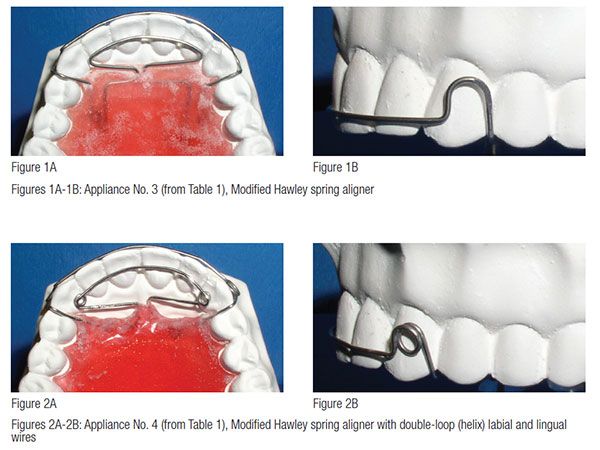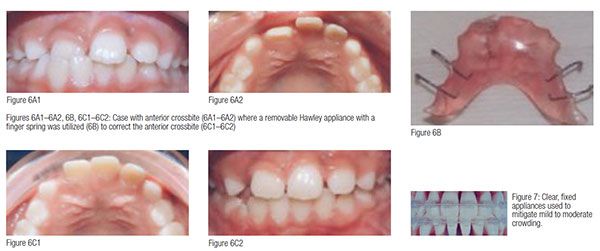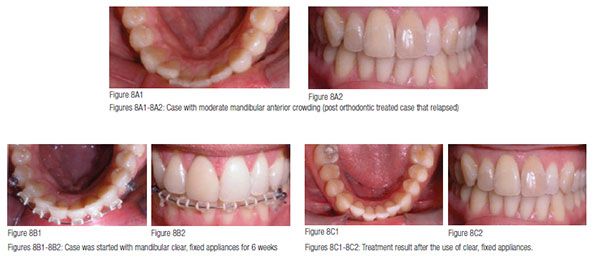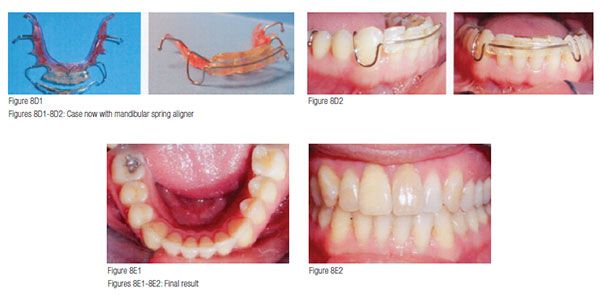Drs. Donald J. Rinchuse, Ethan Drake, Janet Robison, and Dara L. Rinchuse offer insights on the various forms of tooth movement
 Hooke’s Law for springs (and in orthodontics, springs act like beams) simply states, “The extension of (a spring), so the force.” Hooke’s Law applies to stainless steel wires (linear curve) and not for nickel-titanium wires (nonlinear curve) or rubber materials.
Hooke’s Law for springs (and in orthodontics, springs act like beams) simply states, “The extension of (a spring), so the force.” Hooke’s Law applies to stainless steel wires (linear curve) and not for nickel-titanium wires (nonlinear curve) or rubber materials.
[userloggedin]
For systems that obey Hooke’s Law, the extension produced is directly proportional to the load in an exponential manner. That is, the elongation of a bar is directly proportional to the tensile force and the length of the bar, and inversely proportional to the cross-sectional area and the modulus of elasticity.
Figures 1-3 represent various labial and lingual wire configurations for Hawley- type removable appliances that can be used for minor tooth movement (Table 1). Two of the Hawley-type spring aligners pictured in these photos (Figures 1A-1B and 2A-2B) utilize stainless steel wire, with one having a double-helical loop (Figures 2A-2B), which would increase the force range as compared to the appliance in (Figures 1A-1B).
Figure 3 represents an Inman Spring Aligner™, which utilizes push-and-pull NiTi coils that alter the force and range (increase) of the appliance. Table 1 represents forces (grams) of the labial, and labial and lingual (when the appliance is made in a “spring aligner” fashion versus traditional Hawley), wire components of five Hawley-type appliances (Appliance No. 5 – Inman) when stretched 1/2 to 2 mm. Different wire configurations and types of wires can affect the force of various modified Hawley-type appliances as the data in Table 1 illustrates. Note that the forces for Appliance No. 4 and Appliance No. 5 are somewhat comparable. However, Appliance No. 4 is a Hawley-type spring aligner but with labial and lingual stainless steel 0.30-inch double-loop (helix) wire components, while Appliance No. 5 is an Inman Spring Aligner utilizing NiTi coils. Certainly, the force and range of each appliance must be ascertained when deciding on a treatment approach. Forces for invisible aligners are not so easily obtained for a number of reasons; one reason is the practicality of actually utilizing/placing a “gauging” system for measurements.
In deciding on an appliance and/or approach to resolve minor to moderate crowding, there are certainly many ways other than the use of vacuum-formed thermoplastic aligners. Nonetheless, the results of Invisalign® (Align Technologies Inc.) treatments have generally been good1,2 (Figures 4A-4C), but there have also been some mixed reviews.3-8 For sure, the resolution of minor crowding can involve the use of a host of different appliances, such as Hawley spring aligners, Inman aligner, clear braces, and so forth. And, it is possible to use more than one type of appliance, one following the other, for particular cases.
 There is also the possibility that some cases that are treatment planned for orthodontics are best resolved with cosmetic dentistry (Figures 5A and 5B), and vice versa. The advantage of cosmetic dentistry over orthodontics in certain situations is that cosmetic dentistry can alter the size, shape, and color of teeth (Figures 5A and 5B), which is clearly not possible with orthodontic treatment. For middle-aged and older adults, a recommendation of cosmetic dentistry may be a prudent choice. Patients in this age range typically have worn teeth and possibly “dark triangular gingival spaces” due to tooth recession, which can be addressed with dental cosmetic and restorative treatments, i.e., veneers or crowns. In addition, the stability of the results with cosmetic dentistry (orthodontic relapse) is better since the pre-restored teeth are in a somewhat stable position. Of course, there are cases that require both orthodontics and cosmetic dentistry.
There is also the possibility that some cases that are treatment planned for orthodontics are best resolved with cosmetic dentistry (Figures 5A and 5B), and vice versa. The advantage of cosmetic dentistry over orthodontics in certain situations is that cosmetic dentistry can alter the size, shape, and color of teeth (Figures 5A and 5B), which is clearly not possible with orthodontic treatment. For middle-aged and older adults, a recommendation of cosmetic dentistry may be a prudent choice. Patients in this age range typically have worn teeth and possibly “dark triangular gingival spaces” due to tooth recession, which can be addressed with dental cosmetic and restorative treatments, i.e., veneers or crowns. In addition, the stability of the results with cosmetic dentistry (orthodontic relapse) is better since the pre-restored teeth are in a somewhat stable position. Of course, there are cases that require both orthodontics and cosmetic dentistry.
When a patient has no rotated or angulated teeth, a Hawley spring aligner may be the appliance of choice. Removable appliances with finger springs can also be used (Figures 6A-6C). For other patients, the choice may be clear brackets (Figure 7), and, it makes sense in certain situations to start with clear fixed appliances for 4-6 weeks, and then finish with either vacuum-formed clear aligners or a spring aligner (Figures 8A-8E). For patients where the decision is to start with fixed appliances for 4-6 weeks, several wire changes can be made in this time frame. One of the advantages of starting with “braces” and then finishing with a removable appliance(s) is that leveling/aligning/uprighting can be achieved prior to the use of removable appliances. The other advantage is that the teeth are typically “loose” and easier to move after using “braces” — and at the time the vacuum-formed aligner(s) (or spring) is (are) placed.
The modern paradigm for correction of minor to moderate crowding should not be limited to one treatment technique, i.e., vacuum-formed aligners. Just as there are various types of malocclusions and types of crowding, so should there be different treatment approaches, including orthodontic and non-orthodontic. As previously mentioned, there are times when a concomitant orthodontic approach makes sense, and fixed appliances can be initially used followed by vacuum-formed aligner(s).
There are some caveats for treating patients with minor crowding. Although the amount of tooth movement may be minor, these types of cases should be viewed as difficult from a patient satisfaction perspective. There may actually be more complaints from this group of patients than those coming from patients/families with severe and handicapping malocclusion, because even when severe cases do not finish ideally, the patients/families are typically very satisfied considering where they “came from.” On the other hand, if a case is not “that bad” to start, the expectations for a perfect result are higher. Another consideration is that patients/families expect that a “perfect finish” will stay that way forever. Be reminded, many of these minor tooth movement cases (now typically referred to as “Invisalign” cases) are individuals who had had braces before (and usually full braces), and their teeth have relapse. So this may be a situation where the orthodontist has a lifetime commitment to these patients.
The future of vacuum-formed thermoplastic aligners will inevitably lead to the use of “shape memory polymers.” This technology would be somewhat comparable to the advance in orthodontic wire technology going from stainless steel to nickel-titanium. With shape memory technology, it will be possible to fabricate one aligner (“shape memory”) for each patient that will be capable of being deformed (by light or heat, etc.) as it being placed over a crowded arch and then have the ability to slowly return to its original shape once activated again. The activation could be by means of light, heat, or other sources. The single shape memory aligner is fabricated after a “tooth setup” of the patient’s crooked teeth/arch is made into an ideal tooth position. In addition, laser scans can be done directly in the mouth without the need for traditional impressions to produce 3D images of the teeth that can be seamlessly integrated to produce computer models.6,9
1. Boyd RL. Complex orthodontic treatment using a new protocol for Invisalign appliance. J Clin Orthod. 2007;41(9):525-547.
2. Miller KB, McGorray SP, Womack R, Quintero JC, Perelmuter M, Gibson J, Dolan TA, Wheeler TT. A comparison of treatment impacts between Invisalign aligner and fixed appliance therapy during the first week of treatment. Am J Orthod Dentofacial Orthop. 2007;131(3):302.
3. Lagravere MO, Flores-Mir C. The treatment effects of Invisalign orthodontic aligners: A systematic review. J Am Dent Assoc. 2005;136:1724-1729.
4. Djeu G, Shelton C, Maganzini A. Outcome assessment of Invisalign and traditional orthodontic treatment compared with the American Board of Orthodontics objective grading system. Am J Orthod Dentofacial Orthop.2005;128(3):292-298.
5. Kuncio D, Maganzini A, Shelton C, Freeman K. Invisalign and traditional orthodontic treatment postretention outcomes compared using the American Board of Orthodontics objective grading system. Angle Orthod. 2007;77(5):864-869.
6. Ackerman JL, Proffit WR. What price progress? Am J Orthod Dentofacial Orthop. 2002;121(3):243.
7. Rinchuse DJ, Rinchuse DJ. Orthodontics and the general practitioner. J Am Dent Assoc. 2002;133:1160-1164.
8. Miller RJ, Duong TT, Derakhshan M. Lower incisor extraction treatment with Invisalign system. J Clin Orthod. 2002;36(2):95-102.
9. Keim RG. Intraoral scanners have arrived. J Clin Orthod. 2013;47(6):341-342.
Stay Relevant With Orthodontic Practice US
Join our email list for CE courses and webinars, articles and mores







